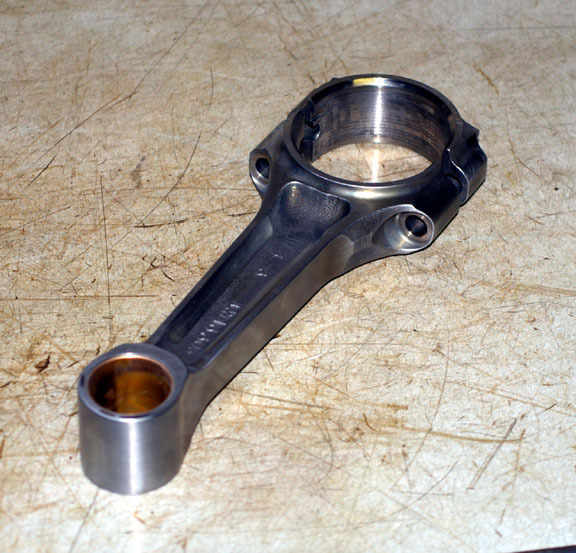Steel parts are sometimes plated prior to final machining of areas that need to be locally surface hardened. IIRC copper/alloys are used. I’m not familiar with Lycoming rods, this could be a factor. Common on cams and followers.
The Lyco conrods do however have some sort of brown coating. No idea what it is, but it isn’t bare steel. They are much less likely to get rust. Same with the conrod bolts.
For example the bare (ground) steel surfaces on my milling machine or lathe corrode at the slightest contact with water or fingerprints, and have to be kept oiled with a special machine tool oil. This is IMHO equivalent to the surface of a cam lobe.
EDIT: Here is one of my actual conrods. My memory served me badly – it has no brown coating. But it wasn’t corroded at all

Vic, I design highly stressed rotating machinery for a living. I’m familiar with the properties of aluminum and steel.
That aside steel con rods do rust, mainly by my observation due to water from combustion and low oil temp. It doesn’t affect the non-ferrous con rod bearings.
the endurance limit is much more an issue with aluminium than with steel. Aluminium has to be stressed much less to get useful life of it. Cylinder heads are one area where you should monitor total hours of operation when deciding to keep them for the next period of use after engine recondition.
One big plus with roller tappets is they will not produce friction wear after long time and dry camshafts when using multigrade oil. I just wonder why corrosion is an issue for cams. Why then do conrods not rust at the same rate, there should be a lot of rust specks on them as well ??? Maybe someone could enlighten me on that one. Corrosion in cylinders is a different matter as being caused by combustion products a lot more than just water vapour , my guess. Allright, conrods are a different alloy than cams, but some rust should show there anyway – if rust is actually the reason for cam wear – which I don´t completely believe . My guess is rather poor material choice .
As to roller tappets: All radials have them since decades, Harleys too for a very long time.
I think he is saying that even the roller tappets don’t prevent the camshaft surface falling apart, if the camshaft is allowed to go rusty, and that doesn’t surprise me because corrosion causes pitting which gradually removes the material, and when you have removed say 0.030" you are through the case hardening, and then it’s downhill all the way 
Frequent flying and Camguard is the only way, unless you are based in Arizona…
Steel has unlimited fatigue life only if operated below what’s called the ‘endurance limit’. That would not be the case for lifter/cam surface stresses.
Re the note from the engine builder, I think people in aviation businesses tend to make up data and rules to suit their own needs. He doesn’t appear to have enough data to support his contention that corrosion is driving roller tappet failures, and he’s not required by FAA to replace parts he independently determines serviceable on certified engines.
I got this from a US engine shop:
To be finickity that logically doesn’t have to follow if you take into account things like infant mortality
Yes I did wonder if my statement was true. It obviously isn’t true for humans e.g. as you get older your actuarial life expectancy (I mean expected date of death) improves.
It must depend on the failure mechanism.
In the case of camshafts, it isn’t fatigue of the bulk metal. It is surface breakup, and the Q is what triggers this.
Incidentally there is an aftermarket camshaft which has an oil gallery inside it. Over the years I have spoken to some people who had one put in, and FWIW my only recollection subsequently was of someone having had problems with it… Are there any other reports?
Peter wrote:
That must obviously be true because whatever life the cam had will now be 2500hrs shorter
To be finickity that logically doesn’t have to follow if you take into account things like infant mortality. Though 2500 hours is a long time so I expect it is.
I am convinced that a camshaft with 2500H TIS will not last as long as a zero time NEW camshaft.
That must obviously be true because whatever life the cam had will now be 2500hrs shorter 
But the steel used doesn’t have a fatigue life AFAIK – unlike say aluminium. Conrods can be re-used “for ever”, for example.
Specifically, if the cam was reground and not re-nitrided, then the case hardening will be thinner. There are allowable limits for regrinding and beyond those it has to be re-nitrided (or whatever the process is) but if the regrind depth was short of those limits, you end up with a cam which definitely has a shorter life.